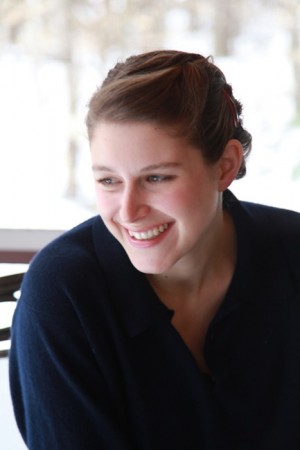Tribeca Talks: Jessica Oreck’s Days of Wild Reindeer Herding in Finland
With a strong desire to make nature films since she was 14, Jessica Oreck stumbled upon one of the world’s most stunning and isolated landscapes, while on the hunt for a Hollywood cowboy. For nearly two years this Louisiana native lived in Finnish Lapland with the Aatsinki, wild reindeer herders whose family has been in the business for six generations — or 10, depending on who’s talking. The life of the last wild reindeer herders — rarely witnessed by outsiders of this close-knit North Salla community — is the subject of Oreck’s new documentary, Aatsinki: The Story of Arctic Cowboys, which premiered at the Tribeca Film Festival in New York City.
Oreck, who has worked at New York’s American Museum of Natural History for close to eight years, credits her time in the famous Butterfly Conservatory as inspiration for her shift from creating strictly nature documentaries into cinematic essays on humans’ relationship with their environment. “It was like watching a science experiment,” she notes. “Different humans from all over the world, changing, or not, in that space. It was fascinating.” It’s no wonder, then, that her first feature film, Beetle Queen Conquers Tokyo (2009), explored Japan’s fascination with bugs.
Her latest film, as quiet as snow and as mesmerizing as the Northern Lights, is a study in perseverance, tradition and a magical landscape, as she and the cowboys track wild reindeer through the forests and meadowlands of Finland with four-wheelers, snowmobiles and, yes, even helicopters. The film offers no political commentary on the struggles reindeer herders face in Northern Europe — indigenous rights, environmental regulations set by the European Union, high unemployment, to name a few — but there is an interactive companion Web site, The Aatsinki Season, developed in large part by co-producer Rachael Teel, which encourages participants to consider the human’s place in the natural world.
In between playing tour guide to Aarne and Raisa Aatsinki, who attended the premiere and learned, among other things, how to eat with chopsticks, Oreck took time out to talk with GALO about eco-tourism, wildlife management and Finnish culture.
GALO: You note in your director’s statement that you stumbled upon brothers Aarne and Lasse Aatsinki while searching for the “modern equivalent of the classic American frontier story.” How did you meet them? And was it difficult for you to get them to agree to participate in your project?
Jessica Oreck: I really wanted to find that Randolph Scott or Gary Cooper type character — that Hollywood cowboy. Originally, I was looking at Siberia, and then my parents moved to Helsinki. And I thought, perfect! I’ll look in Finland, but I couldn’t find anybody that was right for the film. So I called my mom, who, in perfect mom-fashion, said, “There’s a really nice man at the farmer’s market who sells reindeer meat, and I’m sure he knows someone.” I’m pretty sure I rolled my eyes, but I went to meet him, and, sure enough, he had the perfect character! We met in a parking lot in Lapland and drove two hours. Then we met another Finnish guy and drove another two hours. Then we got on a snowmobile for another hour and finally arrived at a cabin in the middle of nowhere with no electricity or running water. We lit a fire and waited. I had no idea what was going on at this point. A few hours later, we heard a snowmobile, and Aarne walked in. Immediately I thought, “Oooh, I think this could work!” Aarne took me on a snowmobile tour of the area: we fell off a small cliff, and we tracked a wolverine. “This is great!” I said and told him I’d return in September. I think he had no idea what he was getting himself into. Now, two years later, he says, “How different my life would have been, if I hadn’t said yes to that!”
GALO: There is little dialogue in the film. Did you find your subjects shy around the camera?
JO: Because they all know the landscape so well, their communication is mostly nonverbal. They’re tuned into a whole different set of signals. There’d be no talk. And then all of a sudden, everyone would stand up and get ready to go because they just knew the time was right. Finns are particularly quiet and reserved. And then you add on top of that being Lappish, and on top of that being cowboys, and it’s this compounded situation where they don’t talk. But I don’t think there were many shy moments. Because I don’t speak their language, it allowed them to say what they wanted to say without censoring themselves. I actually really like working in a language I don’t understand, because it gives the subjects a nice barrier between them and me.
GALO: There is a stark juxtaposition in your film between modern conveniences, such as helicopters and four-wheelers, and the iconic image of cowboys sitting around a campfire cooking food and boiling coffee. How do the Aatsinki family members negotiate such jarring transitions?
JO: They don’t see their way of life as anything extraordinary. They’re on Facebook, and all have cell phones. If there’s a helicopter that makes their life easier, they’re happy to use it. But just because they have those modern conveniences, doesn’t make the winter any less cold. It’s just hard, everyday work. They still have to light a fire every time they stop somewhere and making coffee is part of their social institution. It’s not just for the coffee; it’s also to be part of that community. I had to learn to drink my coffee black. It was part of my adjustment period — how to incorporate myself into their lives in a way that was respectful and yet [would allow me to] be insightful without being intrusive.
(Interview continued on next page)

